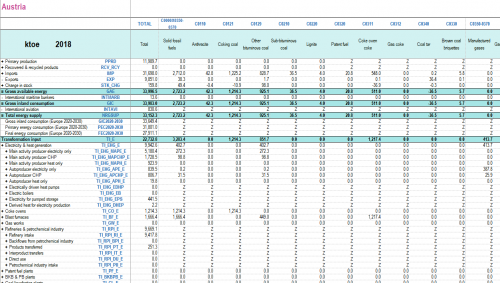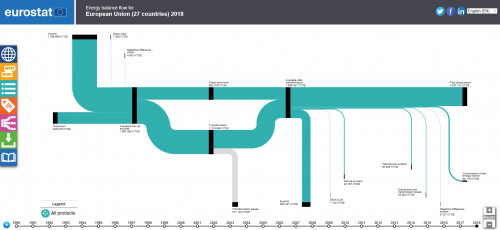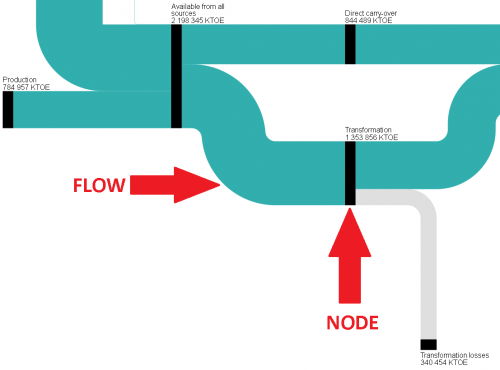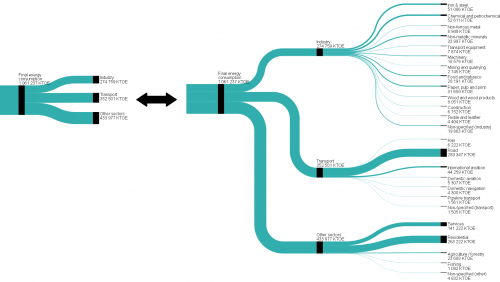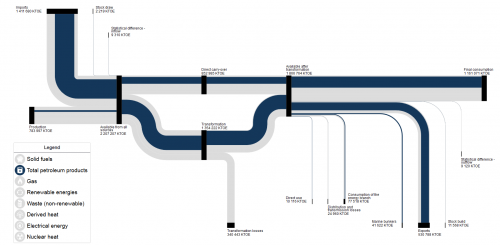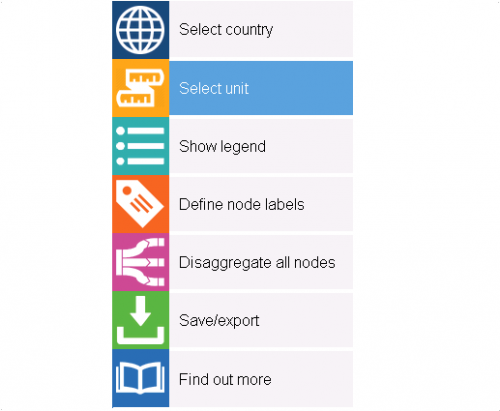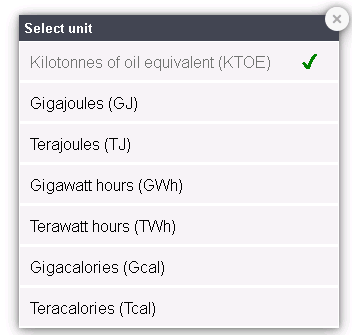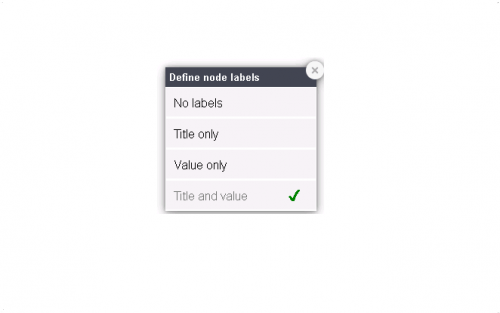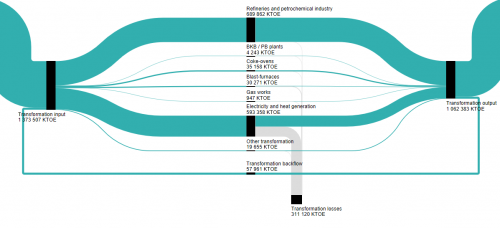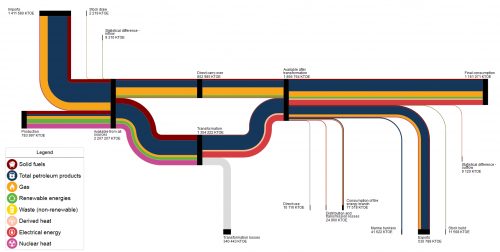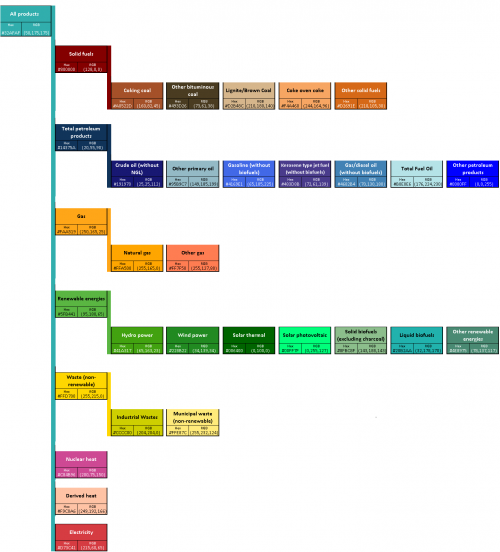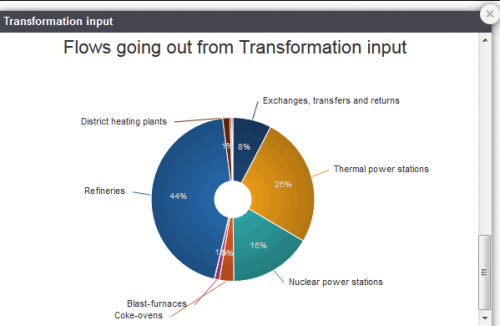Sankey diagrams for energy balance
This article describes the Eurostat Sankey diagrams tool published on the Eurostat website to visualise energy balances. Sankey diagrams provide an overview of the main energy flows and how they contribute to the global energy balance of a certain territory. This article also describes the main features of the Eurostat online Sankey tool and provides instructions on how to use the different menus and available options.
Full article
Introduction
A Sankey diagram is a graphic illustration of flows - like energy, material or money - where they can be combined, split and traced through a series of events or stages (see figure 1). The width of each stream represents the amount of material or energy in the flow. Sankey diagrams , which are typically used to visualize energy transfers between processes, are named after the Irishman Matthew H. P. R. Sankey, who used this type of diagram in a publication on energy efficiency of a steam engine in 1898.
Use for energy balances
Sankey diagrams are ideal for visually representing energy balances. This is because an energy balance represents the contribution and flow of various energy commodities (fuels, heat and electricity, i.e. energy carriers in a marketable form) into the different sectors of the economy (e.g. supply, transformation and consumption) in energy units. A Sankey diagram reproduces – in visual form – energy balances that are sometimes represented in a table or a spreadsheet (see table 1).
What can you do with the Sankey tool?
You can use the Eurostat tool to perform a series of operations and access certain options and levels of detail depending on your preferences. The default view of the Sankey diagram tool is shown in Figure 2. Eurostat's Sankey diagrams are based on a series of nodes connected by energy balance flows:
- the flows represent input and output amounts
- the black nodes represent events or processes, e.g. imports, final energy consumption, etc.
Figure 3 shows an example of a node in black and a flow in green. The width of each flow corresponds to its actual value (energy content). Each flow is defined by 4 dimensions:
- the variable of the balance (e.g. "Final energy consumption")
- the energy product or product family (e.g. "Motor gasoline" or the "Total petroleum products" family)
- the country
- the year.
The flow amount can be expressed in different units of energy measurement, for example ktoe (thousand tonnes of oil equivalent), TJ (terajoules) and GWh (gigawatt hour). Only the non-zero combinations are displayed in the Sankey diagram (for more on this see the methodological remarks below).
How you can interact with a Sankey diagram ?
You can :
- move the mouse over a node - the pointer changes into a small hand, the selected node is highlighted and a small pop-up window shows the name of the node and its energy content
- click a node - a menu pops up with different options
- move the mouse over a fuel inside a flow - the pointer changes into a small hand, the fuel selected is highlighted and a small pop-up window shows the name of the flow and its energy content
- click on a fuel inside a flow - a menu pops up with different options
- click any of the action tiles in the left-hand menu.
NODES
When you click on a node, a pop-up menu (see Figure 4) appears, offering you the following alternatives:
Collapse / Expand this node
If you select “expand”, the node will expand, showing the next level of detail for all flows connected to the node. If the node you clicked on is already expanded, you can click again to collapse the node. This also hides the details that come after the node (for "Transformation input" and all nodes situated after the transformation sector) or before it (for "Transformation output" and all nodes situated before the transformation sector). Figure 5 shows the collapsed and expanded view of the three Final energy consumption sectors.
Some nodes cannot be expanded, specifically:
- external nodes of the Sankey diagram
- nodes that are inside the transformation sector
- the "Direct carry-over" node
- the "Transformation backflow" node.
Time graphs
You can use the Sankey diagram tool to view several graphs showing how different variables change over time. The Y axis is the energy content (in TJ, KTOE, etc. depending on the selected unit) and the X axis represents the years. The following graphs are available:
- the change over time in the amount of fuels passing through the node – you will see two graphs instead of one for nodes in the transformation sector. This is because entering and exiting fuels are different
- the change over time in the energy content of the incoming flows into the node
- the change over time in the energy content of the outgoing flows from the node.
Pie charts
You can also use the Sankey diagram tool to view pie charts showing the distribution of fuels and flows going through the selected node in a selected year. The following pie charts are available:
- distribution of fuels passing through the node – you will see two pie charts instead of one for nodes located in the transformation sector. This is because entering and exiting fuels are different
- distribution of the energy content of the incoming flows – this pie chart is not displayed for external nodes situated before the transformation sector
- distribution of the energy content of the outgoing flows – this pie chart is not displayed for external nodes situated after the transformation sector.
Compare countries
You can also use the Sankey diagram tool to view bar charts showing the distribution of fuels and flows going through the selected node in a selected year for each country (one bar per country). The following bar charts are available:
- distribution of fuels passing through the node – you will see two bar charts instead of one for nodes located in the transformation sector. This is because entering and exiting fuels are different
- distribution of the energy content of the incoming flows – this bar chart is not displayed for external nodes situated before the transformation sector
- distribution of the energy content of the outgoing flows – this bar chart is not displayed for external nodes situated after the transformation sector.
You can filter the countries that you want to compare and also change between absolute and percentage values.
Definitions
When you access “definitions”, you will see a pop-up window with definitions of the node itself and the flows that enter and exit the node. The pop-up window contains links to the relevant definition in the Eurostat concepts and definitions database.
FLOWS
When you click on a flow, you will see the pop-up menu (Figure 6) displaying the following options:
Hide / Show fuel details
If you click on "show fuel details", all flows will show the different fuels flowing inside with a non-zero value. (More on fuels displayed in the Sankey diagram below) If you click on "hide fuel details", all flows will collapse back into a single higher-level fuel family.
Highlight one fuel
You can only use this option when the fuel details are displayed as in the previous option. When you select this option, the selected fuel or fuel family is highlighted. The rest of the fuels or fuel families are in a pale grey colour in the background. To see how the highlight option works, see Figure 7 (for the “Total petroleum products” family).
Display diagram for detailed fuels of the selected fuel family
You can use this option to view a Sankey diagram that shows only the detailed products of the corresponding fuel family. Figure 8 shows the detailed products of the “Renewable energies” family. If you click on “display diagram” when the diagram is already showing a specific fuel family, you will be taken back to the "All products" view.
Definitions
Accessing this option brings up a pop-up window with definitions relating to the selected fuel family and detailed products. The pop-up window contains links to the relevant definition in the Eurostat concepts and definitions database.
ADDITIONAL FEATURES
In addition to the node and flow options, the tool contains a permanent menu (see Figure 9) on the left-hand side with the following options:
- “select country” – use this option to change the country or aggregate of countries. you can select as many countries as you wish and the result will be the Sankey for the group of selected countries (addition of the Sankey of each selected country). See Figure 10 for the country menu
- “select unit” – use this option to change between different energy units. See Figure 11 for the unit menu
- “show legend” – use this option to hide/show the legend
- “select node labels” – use this option to display or hide data values and labels. See Figure 12 for the node labels menu
- “select node details” – you can quickly choose one of three pre-defined node states. These are: “expand all nodes”, “collapse all nodes” and “default view”
- “find out more” – use this option to select one of the following:
- Tutorial: this interactive tutorial will guide you through the different functionalities of the Sankey tool
- Sankey explained: a link to this Statistics Explained article)
- Definitions: link to the Eurostat concepts and definitions database
- Metadata: link to the official metadata for the annual energy balances Energy statistics - supply, transformation and consumption (nrg_bal)
- Sankey dataset: link to the dataset nrg_bal_sd, which contains the data used to display the Sankey diagrams
- "save/export" - use this option to save and/or print the Sankey diagram.
If you want to change the year on display, click on the interactive time line at the bottom of the display. You also have the possibility to see year-on-year changes in an animated way, just by clicking on the play button. You can share the Sankey diagram you are viewing by clicking on one of the social media buttons in the top right corner. To increase or decrease the size of the diagram, you can use the zoom button in the bottom right corner.
Description of flows and nodes of the Sankey diagram
Figure 2 shows the default view for the flow of all energy commodities for all products together and for the EU. The flow runs left to right. Energy commodities:
- enter the energy balance on the left (mainly from production or imports); and
- exit on the right (mainly through final consumption, exports and losses).
The middle part of the diagram also shows:
- which energy commodities are used in their original form; and
- which go through the transformation sector.
Natural gas used for heating in the residential sector is an example of a commodity being used in its original form (i.e. "Direct carry-over"). By contrast, natural gas transformed into electricity in a thermal power plant is an example of an energy commodity going through the transformation sector. The following sections describe the main groups of nodes and their meaning in relation to the energy balance.
Energy available from all sources
The left part of the diagram corresponds to the provision of energy i.e. how the energy is made available to the territory under consideration. This is represented in the Sankey diagram by the "Available from all sources" node). The nodes contributing to the energy available from all sources are:
- Imports – this is energy produced outside and brought into the territory in question to be consumed or transformed into a new energy product
- Production, which is an aggregation of:
- primary production (extraction of energy products from natural sources into a usable form) and
- Recovered and recycled products, which regroup several categories, like supply of renewable energy commodities produced in other fuel balances or certain petroleum products which are reprocessed and recycled.
- Stock draw (energy taken from storage facilities such as gas storage vessels). This involves a positive variation of stock changes.
Once energy is made available to the territory under consideration (through the "Available from all sources" node), it can:
- go through a transformation process – it goes to the "Transformation" node, or
- be used directly in its original form – it goes to the "Direct carry-over" node.
Statistical difference
The statistical difference is the difference between:
- the energy available for final consumption, and
- final consumption.
It can be a good indicator for data accuracy. Statistical difference has been divided into its negative and its positive components (inflow and outflow). The statistical difference - inflow is the negative difference between:
- the energy available for final consumption (calculated using supply data sources), and
- the final consumption (calculated using consumption data sources) for each fuel.
Inflow enters the Available from all sources node.
The statistical difference - outflow is the positive difference between:
- the energy available for final consumption (calculated using supply data sources), and
- the final consumption (calculated using consumption data sources) for each fuel.
Outflow comes between the Available after transformation and Final consumption nodes.
Transformation
The transformation node represents the transformation sector of the energy balance. To understand the processes occurring in the transformation sector, we need to explain what primary and secondary energy commodities are:
- a primary energy commodity is extracted or captured directly from natural resources, such as crude oil, firewood, natural gas or hard coal
- secondary energy commodities (such as electricity, motor gasoline or derived heat) are produced as a result of a transformation process, either from a primary energy commodity or from a different secondary energy commodity.
Transformation represents the energy involved in all activities where one energy commodity (either primary or secondary) is transformed into a secondary energy commodity (e.g. natural gas transformed into electricity in a power plant). The transformation node can be expanded into:
- the transformation input, which is the sum of energy inputs to all transformation processes
- the transformation output, which is the sum of energy obtained as a result of all transformation processes. Between these two nodes, the diagram displays the nodes corresponding to the following transformation processes:
- Transformation - electricity and heat generation includes the production of electricity and/or heat, including renewable energies, like hydro power, wind power and solar photovoltaic, which are transformed into electricity, or the energy transformed in nuclear or thermal power plants (e.g. burning of oil, coal, gas and biofuels) to produce electricity and/or heat, or District heating plants, which are central locations used to produce district heat that is distributed through a network and may be used for process or space heating purposes.
- Transformation - Coke Ovens covers the transformation of coal into coke oven coke, which is the most important raw material for blast furnaces.
- Transformation - Blast-furnaces covers the transformation of coke oven coke into blast furnace gas.
- Transformation - Gas works is the transformation of fuels into gas works gas, which is a flammable gas.
- Transformation - Refineries and Petrochemical industry covers the transformation of crude oil and other intermediary products into refined petroleum products (like gasoline, diesel oil, fuel oil, lubricants, etc.). It also covers the Petrochemical industry, which is the transformation of energy carriers during the production of petrochemicals (chemical products derived from petroleum) in the petrochemical industry.
- Transformation - BKB / PB Plants covers plants used to produce brown coal briquettes and peat briquettes. These are bricks composed of shredded peat or brown coal, compressed to form a slow-burning, easily stored and transported fuel.
- Other transformation includes the following categories: Patent fuel plants, Coal Liquefaction Plants, For Blended Natural Gas, Charcoal production plants (transformation), Gas-to-Liquids (GTL) Plants (transformation), Non-specified Transformation Input.
- Transformation backflow includes all energy commodities obtained as outputs from transformation processes but used as an input to other transformation processes, for example fuels returned from the petrochemical sector to refineries for further processing/blending. Although the "real" backflow is not known from the energy balance, a minimal backflow can be inferred by consistency: any amount of a given product that is present at the Transformation input node, but not provided by Available from all sources, must be a backflow. This minimal backflow is displayed in the Sankey diagram.
- Transformation losses represent energy not accounted for (lost) during the transformation processes. A transformation loss is calculated as the difference between the total input and total output of each transformation flow.
Figure 13 shows the expanded view of the transformation node in the Sankey diagram. After going through transformation, secondary energy products meet those coming from "Direct carry-over" in the "Available after transformation" node. In other words, this node is the addition of direct carry-over and net transformation output (i.e. minus the backflow), meaning that it represents energy quantities that are available for use.
Final consumption
After leaving the Available after transformation node, energy commodities can either flow to become available to final users in the Final consumption node or be consumed in the following activities:
- Stock build - the energy stored in storage facilities (e.g. gas storage vessels). This involves a negative variation of stock changes.
- Exports - energy quantities produced or transformed in the territory which are sent abroad.
- International Marine Bunkers - fuel consumption of ships during international navigation.
- Consumption of the energy branch - the energy consumed to operate installations for energy production and transformation.
- Distribution and transmission losses - include energy losses due to transport or distribution of electricity, heat, gas, as well as pipeline losses.
- International aviation - aviation fuels delivered to aircraft for international aviation (e.g. jet kerosene consumption during international flights).
The energy commodities that flow through the node Final consumption are placed at the disposal of final users. They are either to be consumed:
- for energy in the Final energy consumption node, or
- for non-energy purposes in the Final non-energy consumption node (for instance, oil used as timber preservative).
Energy flowing through the node Final non-energy consumption can be used in the following sectors:
- Final non-energy consumption - Industry covers quantities used for non-energy purposes in the industry sector, for instance coal used to make methanol or ammonia.
- Final non-energy consumption - Transport covers quantities used for non-energy purposes in the transport sector, for instance lubricants for cars.
- Final non-energy consumption - Other sectors covers quantities used for non-energy purposes, for example, in the energy sector, in the transformation sector and in other sectors such as asphalt in road construction.
Final energy consumption
The energy commodities which have not yet left the Sankey diagram will flow through the Final energy consumption node. Final energy consumption covers all fuels used for energy in:
- industry (e.g. steam used to support industrial plant activities)
- transport (e.g. gasoline used in vehicles)
- households (e.g. electricity used at home)
- commercial/services (e.g. gas used for heating a public school)
- agriculture (e.g. diesel oil used in tractors)
- fishing (e.g. fuels used by coastal fishing boats)
- other sectors (e.g. military fuel use).
The energy commodities going through this node will flow to either Industry, Transport or Other sectors nodes.
Final energy consumption - Industry
Final Energy Consumption – Industry covers all fuels used for energy in the industry sector (e.g. steam used to support industrial plant activities). Energy commodities flowing through this node will be consumed in one of the following categories:
- Final Energy Consumption – Industry - Iron and Steel - all fuels used for energy in the iron and steel industry (e.g. steam used to support a blast furnace).
- Final Energy Consumption – Industry - Chemical and Petrochemical - all fuels used for energy in the chemical and petrochemical industry (e.g. petroleum products used as a fuel in a refinery).
- Final Energy Consumption – Industry - Non-Ferrous Metals - all fuels used for energy in the non-ferrous metals industry (e.g. fuel oil used to heat bauxite in the aluminium industry).
- Final Energy Consumption – Industry - Non-Metallic Minerals - all fuels used for energy in the non-metallic minerals industry (e.g. coal used to heat limestone and clay in the cement industry).
- Final Energy Consumption – Industry - Transport Equipment - all fuels used for energy to manufacture motor vehicles, ships, trains, planes and other (e.g. electricity used to power a robot in a car manufacturing company).
- Final Energy Consumption – Industry - Machinery - all fuels used for energy to manufacture machinery, computers, optical and electrical equipment, etc. (e.g. electricity used to power a robot in a computer chip manufacturing company).
- Final Energy Consumption – Industry - Mining and Quarrying - all fuels used for energy in the ore-extraction industry (e.g. fuel used to power a rock crusher machine in a granite quarry plant).
- Final Energy Consumption – Industry - Food and Tobacco - all fuels used for energy in the food and tobacco industry (e.g. steam used in a UHT treatment to sterilise dairy products in the milk industry).
- Final Energy Consumption – Industry - Paper, Pulp and Print - all fuels used for energy in the paper, pulp and print industry (e.g. electricity used to power a belt conveyor in a paper manufacturing company).
- Final Energy Consumption – Industry - Wood and Wood Products - all fuels used for energy to manufacture wood and wood products, excluding paper (e.g. electricity used to power a wood saw for the production of assembled parquet floors).
- Final Energy Consumption – Industry - Construction - all fuels used for energy in the construction, demolition and civil engineering sectors (e.g. gasoline used to power a demolition bulldozer).
- Final Energy Consumption – Industry - Textile and Leather - all fuels used for energy in the textile and leather industry (e.g. electricity used to power a leather drying machine).
- Final Energy Consumption – Industry - Non-specified (Industry) - all fuels used for energy in other not covered industry sectors.
Final energy consumption - Transport
Final energy consumption - Transport covers the energy used for all transport activities (e.g. electricity in rail, liquid fossil fuels in road, kerosene in aviation, fuel oil in domestic navigation). Energy commodities flowing through this node will be consumed in one of the following categories:
- Final Energy Consumption – Transport - Rail - the energy used for rail transport activities (e.g. electricity in rail traffic or electrified urban transport systems).
- Final Energy Consumption – Transport - Road - the energy used for the propulsion of road vehicles (e.g. gasoline or diesel oil for cars).
- Final Energy Consumption – Transport - Domestic aviation - aviation fuels delivered to aircraft for domestic aviation (e.g. jet kerosene consumption during domestic flights).
- Final Energy Consumption – Transport - Domestic Navigation - quantities delivered to vessels of all flags not engaged in international navigation (e.g. fuel oil consumed by a ship in a journey between two ports of the same country).
- Final Energy Consumption – Transport - Consumption in Pipeline transport - the energy used to support and operate pipelines transporting gases, liquids and other commodities (e.g. energy used to pump natural gas through a pipeline).
- Final Energy Consumption – Transport - Non-specified (Transport) - quantities used for transport activities not covered elsewhere (e.g. fuels used in ports for ships' unloaders).
Final energy consumption - Other sectors
Final energy consumption – Other sectors covers quantities consumed by sectors that cannot be classified as energy, industry or transport (e.g. energy consumed in private households, commerce, administrative bodies). Energy commodities flowing through this node will be consumed in one of the following categories:
- Final Energy Consumption - Other Sectors - Services covers energy consumed by business and offices in the public and private sectors (e.g. electricity consumed by a public administrative building or heating oil consumed in a private school).
- Final Energy Consumption - Other Sectors - Households - energy consumed by all households (e.g. electricity for lighting and powering domestic appliances, heating fuels such as gas, wood or gasoil, etc.).
- Final Energy Consumption - Other Sectors - Agriculture/Forestry - energy consumed for agriculture, hunting and forestry (e.g. diesel consumed by tractors).
- Final Energy Consumption - Other Sectors - Fishing - energy consumed for inland, coastal and deep-sea fishing (e.g. fuel oil consumed by a fishing boat).
- Final Energy Consumption - Other Sectors - Non-specified (Other) - final energy consumption not classified under any other code (e.g. military fuel use).
Description of fuels used in the Sankey diagram
The default view of the Sankey diagram shows one energy commodity, called "All products" or Total fuels, which is depicted using the colour turquoise (RGB 50, 175, 175). All products is the sum of all energy products and is composed of the following fuel families:
- solid fuels (coal)
- total petroleum products (crude oil and derived petroleum products)
- gas
- nuclear heat
- derived heat
- renewable energies
- electricity
- waste.
Figure 14 shows the Sankey diagram for all the fuel families. Each fuel family is represented by a different colour. You can also go into a selected fuel family to see which individual fuels make up that family. The individual fuels are represented by a single colour within the same range as the corresponding family.
Figure 15 shows the colour associated with each family and each individual energy product (fuel) in the Sankey diagram. There you can see the different fuel families displayed in the Sankey tool and the individual products shown in each family.
What follows is a list of the different fuel families, the individual products included in each family and the colours used to represent the different fuel families in the Sankey diagram.
Solid fuels
Solid fuels are fossil fuels covering various types of coals and solid products derived from coals. They consist of carbonised vegetable matter and usually have the physical appearance of a black or brown rock. The colour in the Sankey diagram is brown (RGB 128, 0, 0). The individual products in this family are:
- Coking Coal is a solid fossil fuel which is used in blast furnaces.
- Other Bituminous Coal is a solid fossil fuel mainly used for steam raising purposes (in other words, to increase the temperature and/or pressure of steam).
- Lignite/Brown Coal is a solid fossil fuel presented as a soft brown combustible sedimentary rock. It is used almost exclusively as a fuel for steam-electric power generation.
- Coke Oven Coke is a solid fossil fuel obtained from carbonization of coal, principally coking coal, at high temperature. It is used mainly in the iron and steel industry.
- Other solid fuels covers the rest of solid fossil fuels and includes Patent Fuels, Anthracite, Sub-bituminous Coal, Gas Coke, Coal Tar, BKB (brown coal briquettes), Peat and Peat products, as well as Oil shale and oil sands.
Total Petroleum products
Total petroleum products are fossil fuels (usually in liquid state) and include crude oil and all products derived from it (e.g. when processed in oil refineries), including motor gasoline, diesel oil, fuel oil, etc. The colour in the Sankey diagram is blue (RGB 20, 55, 90). The individual products in this family are:
- Crude oil is a mineral oil, extracted from underground reserves, comprising a mixture of hydrocarbons and associated impurities such as sulphur. It was formed when large quantities of dead organisms, usually zooplankton and algae, were buried underneath sedimentary rock and subjected to both intense heat and pressure.
- Other primary oil includes the following primary (not processed) oil products: Natural gas liquids (NGL), Refinery feedstocks, Additives/Oxygenates and Other hydrocarbons.
- Motor Gasoline, also known as petrol, is obtained by processing crude oil. It is a transparent liquid that is used primarily as a fuel in internal combustion engines.
- Gas/diesel oil is obtained by processing crude oil. It is a liquid fuel used in diesel engines.
- Kerosene type jet fuel is obtained by processing crude oil. It is a liquid fuel used in aviation engines.
- Total fuel oil or heavy fuel oil is obtained by processing crude oil. It is a liquid fuel used in a furnace or boiler for the production of heat or in an engine for the generation of power (for example in maritime transport).
- Other petroleum products include Refinery gas, Ethane, Liquified petroleum gas (LPG), Aviation gasoline, Other kerosene, Gasoline type jet fuel, Naphtha, White Spirit and SBP, Lubricants, Bitumen, Petroleum coke, Paraffin Waxes and Other Oil Products.
Gas
Gas includes natural gas and derived gases (the latter called "other gases" here). The colour in the Sankey diagram is orange (RGB 250, 165, 25). The individual products in this family are::
- Natural gas consists mainly of methane (CH4). It is taken from natural underground reserves.
- Other gas consists of derived gases manufactured in some industrial processes. They include Coke Oven Gas, Blast Furnace Gas, Gas Works Gas and Other recovered gases.
Nuclear heat
Nuclear heat is the thermal energy produced in a nuclear power plant (nuclear energy). It is obtained from the nuclear fission of atoms, usually of uranium and plutonium. The colour in the Sankey diagram is pink (RBG 200, 75, 150). Nuclear heat cannot be split into individual products.
Derived heat
Derived heat is used for warming spaces and for industrial processes and is obtained by burning combustible fuels like coal, natural gas, oil, renewables (biofuels) and wastes, or also by transforming electricity to heat in electric boilers or heat pumps. The colour in the Sankey diagram is salmon (RGB 249, 192, 166). Derived heat cannot be split into individual products.
Renewable energies
Renewable energies are energy sources that replenish (or renew) themselves naturally, such as solar, wind, hydro, geothermal, biofuels, renewable wastes, etc. The colour in the Sankey diagram is green (RGB 95, 180, 65). The individual products in this family are:
- Hydro power refers to the energy obtained from falling or running water, which is converted into electricity in hydroelectric plants.
- Wind power refers to the energy obtained from wind, which is converted into electricity in wind turbines.
- Solar thermal is the energy collected from the sun by means of solar panels or similar devices to produce domestic hot water or electricity in solar thermal power plants.
- Solar photovoltaic is the direct conversion of sunlight into electricity by means of photovoltaic panels
- Solid biofuels are organic (non-fossil) solid materials of biological origin that can be burnt to produce heat or electricity, like fuelwood, wood residues, etc.
- Liquid biofuels are organic (non-fossil) liquid materials of biological origin that can be burnt to produce heat or electricity. They can be used to replace petroleum products in motor engines, for example. They include Biodiesels, Biogasoline, Bio jet kerosene and Other liquid biofuels.
- Municipal waste (renewable)
- Biogas
- Geothermal energy
- Ambient heat (heat pumps)
- Other renewable energies include Tide, Wave and Ocean and Charcoal
Electricity
Electricity is a form of energy associated with the presence and flow of electric charges. It has a very wide range of applications in almost all kinds of human activity ranging from industrial production, household use, agriculture or commerce and it is normally used for running machines, lighting and heating. The colour in the Sankey diagram is red (RGB 215, 60, 65). Electricity cannot be split into individual products.
Waste (non-renewable)
Waste (non-renewable) consists of materials coming from combustible industrial, institutional, hospital and household wastes such as rubber, plastics, waste fossil oils and other similar types of wastes, which can be either solid or liquid. The colour in the Sankey diagram is yellow (RGB 255, 215, 0). The individual products in this family are:
- Municipal waste (non-renewable) covers wastes produced by households and the tertiary sector from non-renewable origin, like plastics, synthetic rubber, inorganic materials, etc. which are incinerated to produce electricity and/or heat.
- Industrial wastes cover wastes of industrial non-renewable origin (solid and liquids), like used oils, chemical solvents, paper products, etc. which is burnt to produce electricity and/or heat.
How to interpret a Sankey diagram
To illustrate how to interpret a Sankey diagram as displayed by the Eurostat Sankey tool, we have selected an example showing the Sankey for the EU (only for illustrative purposes, data correspond to an old release for 2014), showing details for fuel families.
- If you look at the Sankey diagram in Figure 14, you can see that most of the energy available in the EU is imported, while only a smaller proportion is produced internally.
If you select the "Pie charts" option in the Available from all sources node, you can see the distribution of incoming fuels and flows.
- In the example, around 36% of the energy comes from the Production flow, against 64% which is imported. The pie charts show that most of the energy available is in the form of total petroleum products (including crude oil), followed by natural gas, solid fuels, renewable energies and nuclear heat.
If you want to see more detail on the composition of each family, you can view the detailed Sankey for each family and the relevant pie charts.
- In the example, 62% of the total energy available in the EU goes into the transformation sector, while 38% is used without any transformation (i.e. Direct carry-over).
If you expand the "Transformation" node, you can see the transformation sectors in detail (Figure 16). You can obtain data on the composition of sectors and fuels by displaying pie charts in every node you are interested in. If you do this in the Transformation input node, for example, you can see that:
- the family petroleum products constitute almost half of the amount of fuels sent to Transformation
- the Refineries sector deals with 44% of the fuels going into transformation (Figure 17).
If you want to see how the Refineries sector changes over time in that node, select the "Time graphs" option. Figure 18 shows an example of one of the displayed graphs, namely “Fuels going out from refineries”. If you are interested in the composition of fuels sent into Thermal power stations, you can obtain it by displaying pie charts in that node.
- In the example, 53% are solid fuels, followed by 26% gas and 14% renewable energies (combustible renewables like solid or liquid biofuels).
You can use the "Exchanges, transfers and returns" node to see the amount of renewable energies produced directly in the form of electricity (like hydro, wind or solar photovoltaic). If you want to see details of each renewable energy source in each node, you can do this by displaying the detailed family diagram for the renewable energies flow. The "Available after transformation" node shows fuels ready to be used or exported.
- If you go to the Exports node and display the pie charts, you will see that the energy exported by the EU in 2014 consisted mainly of petroleum products.
- If you display the pie charts for the “Total petroleum products” family in the Exports node, you will see that most of them (86%) are secondary energy products like gas/diesel oil, gasoline and fuel oil, while only 14% is crude or other primary oil.
The "Final energy consumption" node shows the amount of fuels consumed for energy purposes in the different final sectors (industry, transport, residential, commercial, etc.). Most of the fuels consumed in the transport sector are petroleum products and most of them are consumed in road transport. You can take a detailed look at each individual sector. For the residential sector, most of the energy consumed is gas, followed by electricity and renewable energies (mostly solid biofuels and some solar thermal). You can analyse the rest of the sectors and/or flows in detail using a combination of the different features offered by the Sankey tool. These will give you a general and/or detailed overview of the energy flows/sectors in the territory in question.
Methodology notes
The Sankey diagram tool takes its data from the "Sankey diagram dataset - annual data (nrg_bal_sd)" in the Eurostat Energydatabase. The Sankey diagram is a visual representation of an energy balance. The nrg_bal_sd dataset takes its data from the "Complete energy balances - annual data (nrg_bal_c)" dataset. There are some limitations on how some of the balance aggregates can be shown. For this reason, some balance aggregates have to be displayed in a different form and others cannot be displayed at all. This is mainly because negative flows cannot be represented visually. Therefore, to avoid having large artificial backflows, two adjustments have to be made:
- Fuels entering the Sankey have to be displayed before the transformation sector. In this way, they also make sense for products consumed in transformation.
- Exiting fuels need to be displayed after the transformation sector. In this way, they also make sense for products produced in transformation.
Modified or missing aggregates in Sankey
Here are some examples of aggregates that are displayed in a different way or which cannot be displayed at all in the Sankey diagram:
- Stock changes: this aggregate from the energy balance does not appear in the Sankey diagram. Stock draw and stock build are displayed instead. A fuel taken from stocks (stock draw) can be consumed in the transformation sector, so it has to be displayed before this sector. Conversely, a fuel sent to stock (stock build) could have appeared only after transformation, so the flow in the Sankey diagram needs to be displayed after the transformation sector. For this reason, there is no "stock changes" flow in the Sankey diagram, but rather two distinct flows: "stock build” and "stock draw".
- Imports and exports: imports are displayed before the transformation sector and exports after the transformation sector for the same reasons as with stock changes above. This makes it impossible to show the net imports flow, as both flows cannot be meaningfully combined in the Sankey diagram.
- Note: for aggregates of countries (e.g. EU), imports and exports are calculated as the sum of total imports or total exports for each of the countries included in the aggregate, without subtracting the internal trade between the countries of the aggregate (i.e exports of one country of the aggregate to another country of the aggregate are not subtracted).
- Gross inland consumption: cannot be displayed in the Sankey diagram since it depends on net imports. As explained above, net imports cannot be displayed in the Sankey.
- Statistical difference: statistical difference is simply a positive or negative number in the table of the energy balance. In the Sankey diagram, it is either an incoming or outgoing flow depending on its sign.
New aggregates in Sankey
Conversely, some new aggregates need to be included in the display of the Sankey diagram. This is the case for the following aggregates, which are not shown in the energy balance:
- Available from all sources: the aggregate where all the entering flows converge, namely imports, production and stock draw
- Transformation backflow: the minimal backflow needed to cover all transformation inputs, for an exact definition see above
- Direct carry-over: the total amount of fuels which are directly consumed and do not go through transformation
- Available after transformation: the sum of transformation and direct carry-over
- Final consumption: the sum of the Final energy consumption and Final non-energy consumption energy balance flows. This is created only to introduce the statistical difference in a meaningful way in the display.
In addition, some flows shown separately in the energy balance are put together in the Sankey diagram. This is done especially when they are very small and where separating them does not add any value in the display. For an example of this see the "Other production" or "Transformation losses" nodes created exclusively for the Sankey diagram. The nodes are defined above.
What to do with small or negative flows
When handling very small flows in the Sankey diagram, a special methodology is needed. Some flows may even be negative due to statistical discrepancies. The method used is as follows: an ad hoc threshold is applied to decide whether any given fuel on display inside a Sankey diagram flow should be drawn or not. This threshold is quite arbitrary and reflects only the limitations on what can be shown. In detail, two rules are applied to each single flow in the Sankey tool:
- The entire flow is drawn only if the energy content of at least one fuel on display inside this flow, expressed in the currently selected unit, rounds to 1 or more.
- If the resulting width of a fuel inside this flow on the screen, expressed in pixels, is less than 0.5, it is increased to 0.5 pixels.
Nodes to which no flow is attached after this selection (i.e. none flowing in and none flowing out) are not drawn either.
Direct access to
- Energy, see:
- Energy statistics, quantities - annual data (nrg_quanta)
- Energy balances (nrg_bal)
- Sankey diagram dataset - annual data (nrg_bal_sd)
- Energy balances (nrg_bal)
- Energy statistics - energy balances (ESMS metadata file — nrg_bal_esms)
- Regulation (EC) No 1099/2008 of 22 October 2008 on energy statistics
- Summaries of EU legislation: Common system for the production of energy statistics

